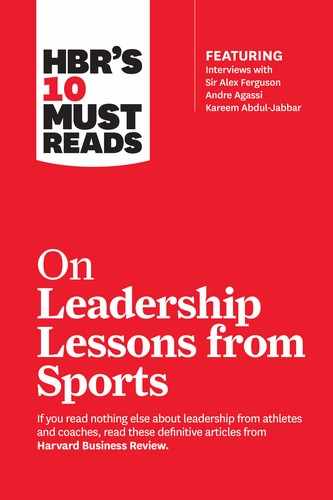Looking Past Performance in Your Star Talent
by Mark de Rond, Adrian Moorhouse, and Matt Rogan
THE NBA DRAFT has, since 1950, been the means of bringing the cream of college basketball talent into the professional ranks. Pro teams take views and stake fortunes on those college kids most likely to step up successfully.
In 1998, Briton Michael Olowokandi was first pick, drafted to the L.A. Clippers. His selection was big news, not because the soccer-obsessed Britons had finally produced a basketball talent, but because he had only been playing the game for five years, since 1993. Although Olowokandi had only played basketball in the U.K. for two years before his freshman year, coaches at the University of the Pacific were intrigued by his seven-foot frame and recruited him. He had no game to speak of, but huge potential. It was unclear until very late in his college career that he was NBA material, let alone a potential number-one pick.
Sports teams under salary caps rely on balancing performance with potential. American sports in particular have led the world in professionalizing this skill. Michael Lewis’s Moneyball describes how the Oakland A’s used data analysis to understand the trade-off between performance, potential, and player value on the open market. In U.S. pro sports, this cat is now out of the bag. Performance data in itself is now a commodity purchase, so mainstream that Brad Pitt starred in Moneyball the movie.
On one level, business is slowly catching on. Well-handled psychometric tests provide not only a currency for assessing personal traits, but also potential fit within an organization. In theory, we finally have an objective view of who our number-one pick should be. In practice, this is no time to be smug. Recent research suggests that 70% of our current crop of high performers in business lack critical attributes essential to success in future roles.1 We may have all the data in the world, yet we’re still not consistently making the right calls.
Why not? Perhaps progress in sports offers a clue. Given that a data-based view of potential versus value is now held by each MLB team, Billy Beane, the brains behind the Moneyball revolution, is thinking differently. He has said, “Data is now only part of the picture. When the competition zigs, I have to zag.” While the number crunching still happens, he is also sending his scouts to understand the backgrounds of his prospective draft picks and trades. He wants to meet their parents and their friends, to observe them in the evenings after a defeat. The best soccer managers in England, Alex Ferguson and Arsene Wenger, do the same. They do so because they don’t just want a theoretical view of potential; they also want to find clues as to what lies beneath. They want to discover how resilient each talented individual might be, and how prone they could be to derailment.
Professional sports require dedication and performance under pressure. In this environment, personal traits and preferences that manifest themselves as strengths can become counterproductive. Self-belief can become unhelpful ego, which has an impact on the ability to learn from setbacks. A win-at-all-costs mentality can turn into a desire to bend the rules a little too far. Understanding potential derailment minimizes the risk of hiring talented but flawed individuals.
We see this tendency in business too, of course. In his book Personality and the Fate of Organizations, Robert Hogan explains, “There are strengths and weaknesses associated with various derailment factors … good things taken to the extreme turn into bad things.” For example, attention to detail can later turn into a career-limiting desire to micro-manage as opposed to lead an organization. Developing self-awareness is at the root of any successful strategy to deal with derailment. The New York Giants don’t just recruit those most likely to cope; they run a program called “Choices, Decisions and Consequences” to help their players proactively understand and manage their own potential causes of derailment.
Business, like sports, is a roller coaster. Success is high profile, failure higher still. Given this, any outlook that fails to recognize the potential threat of derailment and to prize the resilience necessary for coping with setbacks is an incomplete picture. We characterize future potential in terms of three dimensions—commitment, ability, and resilience. Those individuals in sport or business with the highest potential are replete in all three. “Loyal Servants” lack the ability to progress much further but have the commitment and resilience to deliver for the long term. “Prima Donnas” are full of ability and resilience but lack the commitment to stay the course. They can become the stars of the future, but it might not be with you. “Brittle Stars” are full of ability and commitment, but can derail under pressure. They can deliver for you, as long as you provide the necessary support along the way.
Like every team, your business will blend Brittle Stars, Loyal Servants, and Prima Donnas as well as the highest-potential talent. Each group can be supported and challenged to move forward. In that spirit, here are three key insights from sports’ top talent developers:
Just like the University of the Pacific: Remember current performance is often a misleading barometer of future potential.
Just like Manchester United and Arsenal Soccer Clubs: Insist on understanding the people behind the data.
Just like the New York Giants: Encourage your talent to understand and actively manage their own personal sources of potential derailment.
Carefully assessing your top talent is more than picking the best of the best. In looking at your team, you can see what your stars bring to the table and prevent the possibility of future derailment.
Originally published on June 2011 on HBR.org.
Note
1. Jean Martin and Conrad Schmidt, “How to Keep Your Top Talent,” Harvard Business Review, May 2010.
